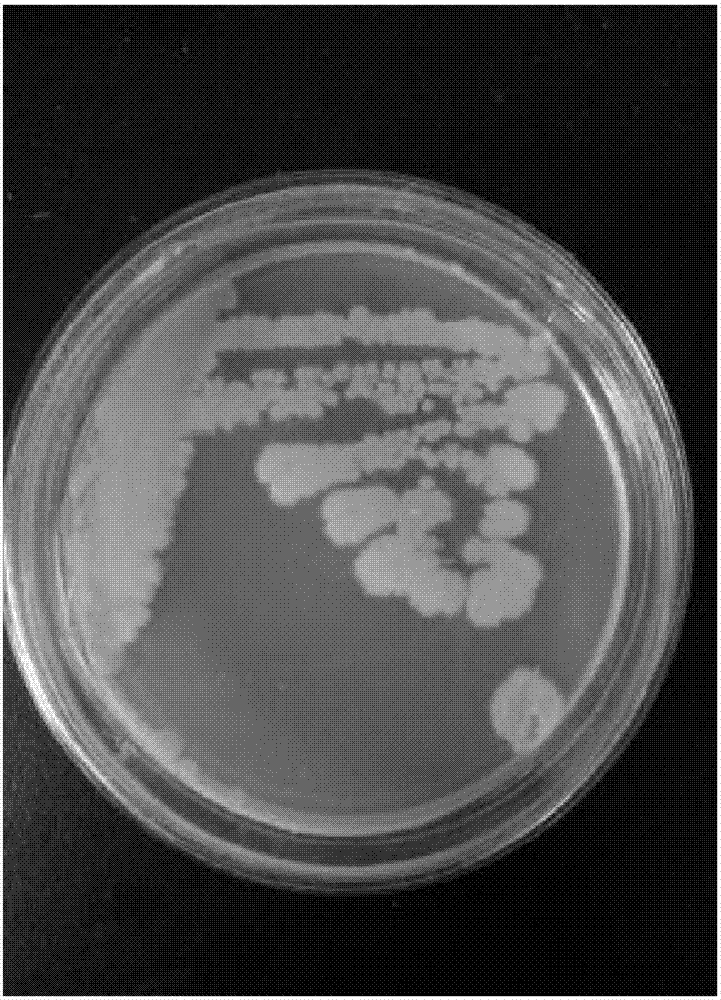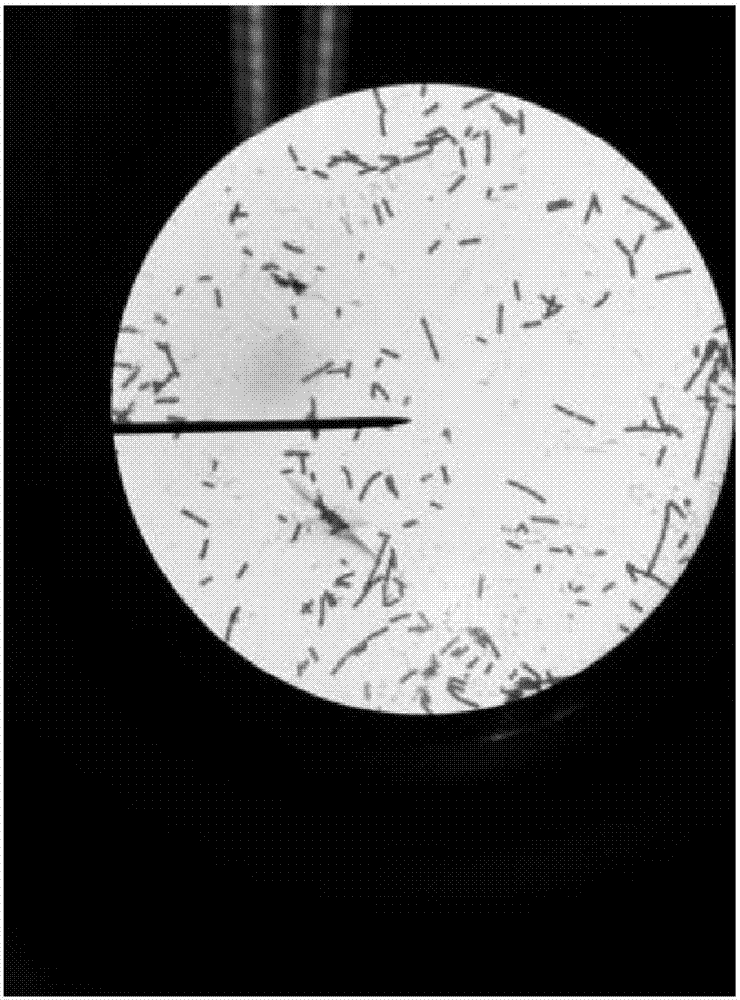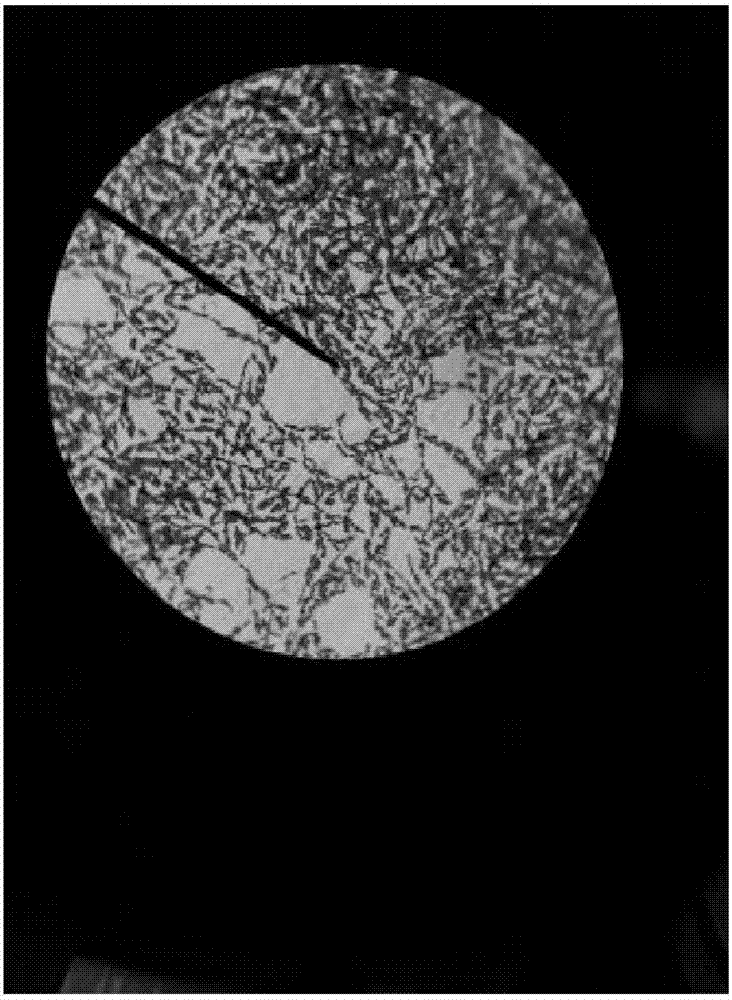Bacillus cereus and application thereof in degradation of feathers
A technology for Bacillus cereus and feathers, which is applied in the application field of environmental resources in aquaculture industry, can solve problems such as undisclosed simultaneous degradation of feathers and the like, and achieve the effects of good degradation and ecological promotion.
- Summary
- Abstract
- Description
- Claims
- Application Information
AI Technical Summary
Problems solved by technology
Method used
Image
Examples
Embodiment 1
[0048] Example 1: Culture identification of strains.
[0049] 1. Obtaining the original strain
[0050] A few healthy pigeons were taken from a pigeon farm in Nanjing, and the pigeons were dissected next to an alcohol lamp, and the contents of their cecum were directly streaked and inoculated on a common agar plate with a sterilized inoculation loop. For the morphology of a single colony, take the diameter of about 6mm, the irregular edge is milky white and opaque, and the surface is rough and white wax-like colony for further isolation and culture, and pure culture is carried out after obtaining a single colony. Bacterial isolation and culture results: Through bacterial isolation and culture, a pure cultured bacterium was obtained, named NJ-02. The isolated bacteria were gram stained and spore stained, and then observed under the oil lens of a light microscope. The results were G+ medium-sized bacilli with spores, most of them were single, a few were 3-5 short chains, the s...
Embodiment 2
[0071] Example 2: Observation of the degradation morphology of the feathers of chickens, ducks, geese and pigeons by bacteria.
[0072] In order to observe whether the isolated and cultured NJ-02 Bacillus cereus can degrade the feathers of chickens, ducks, geese and pigeons, NJ-02 Bacillus cereus was designed to degrade the feathers of chickens, ducks, geese and pigeons. Observation test on the degradation morphology of poultry feathers. Add 5 ml of degraded feather basal medium (K 2 HPO 4 0.4g / L, NaCl 0.5g / L, FeSO 4 0.1g / L initial pH 7.5), and a piece of clean poultry feathers (the feathers of chickens, ducks, geese and pigeons are all treated and observed in the same way), autoclave 15 pounds at 121°C for 15min, after cooling, inoculate an appropriate amount of bacteria isolated and cultured, set at 37 The results were observed after culturing in a ℃ incubator for 5d-15d.
[0073] 1. Degradation of goose feathers: Feather flakes on the 5th day: the feather trunk is no ...
Embodiment 3
[0089] Example 3: Determination of Feather Degradation Residues of Bacteria on Chicken, Duck, Goose, Pigeon and Other Poultry
[0090] Feather meal pretreatment: soak the collected feathers in 0.04% NaOH solution at 20-25°C for 1 hour, rinse with clean water, filter, dry, and pulverize with a particle size between 750 μm and 1200 μm for later use.
[0091] Take 24 conical flasks with a size of 250ml, add 1 gram of chicken feather powder with a particle size of 750μm to 1200μm and 50ml of fermentation medium (fermentation medium formula is as follows: K 2 HPO 4 0.4g / L, FeSO 4 0.1g / L, NaCl 0.5g / L, solvent is water, initial pH 7.5, autoclave), autoclave 15 pounds at 121°C for 15min, and wait for cold use. Then divided into two groups, the first group of 12, each inoculated with an appropriate amount of isolated and cultured bacteria NJ-02 (not less than 10 9 CFU / ml), another group of 12 were used as blank control, placed in a shaking incubator at 37°C at 150 rpm / min on the 3...
PUM
| Property | Measurement | Unit |
|---|---|---|
| particle diameter | aaaaa | aaaaa |
Abstract
Description
Claims
Application Information
 Login to View More
Login to View More - R&D
- Intellectual Property
- Life Sciences
- Materials
- Tech Scout
- Unparalleled Data Quality
- Higher Quality Content
- 60% Fewer Hallucinations
Browse by: Latest US Patents, China's latest patents, Technical Efficacy Thesaurus, Application Domain, Technology Topic, Popular Technical Reports.
© 2025 PatSnap. All rights reserved.Legal|Privacy policy|Modern Slavery Act Transparency Statement|Sitemap|About US| Contact US: help@patsnap.com



